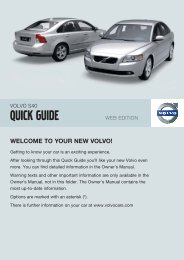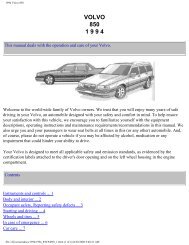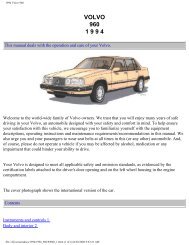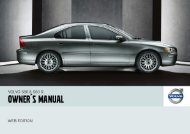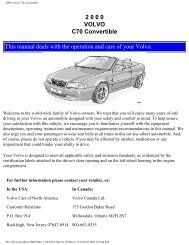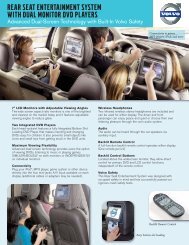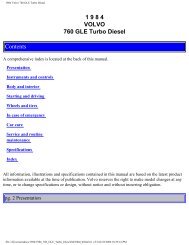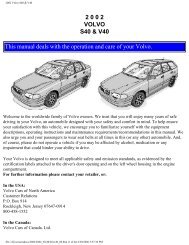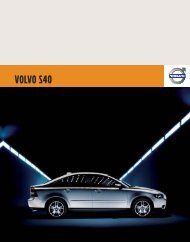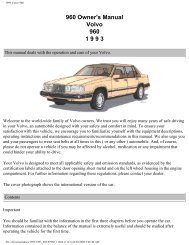- Page 2 and 3:
DEAR VOLVO OWNER THANK YOU FOR CHOO
- Page 4 and 5:
Contents 03 Climate control General
- Page 6 and 7:
Contents 09 Maintenance and service
- Page 8 and 9:
Introduction Volvo Cars and the env
- Page 10 and 11:
Introduction Reducing environmental
- Page 12 and 13:
SAFETY 01
- Page 14 and 15:
01 Safety Seatbelts 01 Seatbelt rem
- Page 16 and 17:
01 Safety Airbag system 01 Warning
- Page 18 and 19:
01 Safety Airbags (SRS) 01 SRS syst
- Page 20 and 21:
01 Safety Activating/deactivating t
- Page 22 and 23:
01 Safety Side airbags (SIPS bags)
- Page 24 and 25:
01 Safety Inflatable Curtain (IC) 0
- Page 26 and 27:
01 Safety WHIPS 01 Do not obstruct
- Page 28 and 29:
01 Safety Crash mode 01 Driving aft
- Page 30 and 31:
01 Safety Child safety 01 Decal loc
- Page 32 and 33:
01 Safety Child safety 01 Integrate
- Page 34 and 35:
01 Safety Child safety 01 Fitting a
- Page 36 and 37:
INSTRUMENTS AND CONTROLS 02
- Page 38 and 39:
02 Instruments and controls Overvie
- Page 40 and 41:
02 Instruments and controls Overvie
- Page 42 and 43:
02 Instruments and controls Combine
- Page 44 and 45:
02 Instruments and controls Indicat
- Page 46 and 47:
02 Instruments and controls Indicat
- Page 48 and 49:
02 Instruments and controls Informa
- Page 50 and 51:
02 Instruments and controls Lightin
- Page 52 and 53:
02 Instruments and controls Left-ha
- Page 54 and 55:
02 Instruments and controls Right-h
- Page 56 and 57:
02 Instruments and controls Cruise
- Page 58 and 59:
02 Instruments and controls Steerin
- Page 60 and 61:
02 Instruments and controls Parking
- Page 62 and 63:
02 Instruments and controls Power w
- Page 64 and 65:
02 Instruments and controls Rearvie
- Page 66 and 67:
02 Instruments and controls Rearvie
- Page 68 and 69:
02 Instruments and controls Power s
- Page 70 and 71:
02 Instruments and controls Persona
- Page 72 and 73:
CLIMATE CONTROL 03
- Page 74 and 75:
03 Climate control General informat
- Page 76 and 77:
03 Climate control Manual climate c
- Page 78 and 79:
03 Climate control Electronic clima
- Page 80 and 81:
03 Climate control Air distribution
- Page 82 and 83:
03 Climate control Fuel-driven heat
- Page 84 and 85:
INTERIOR 04
- Page 86 and 87:
04 Interior Front seats Power seat
- Page 88 and 89:
04 Interior Interior lighting The p
- Page 90 and 91:
04 Interior Storage spaces in the p
- Page 92 and 93:
04 Interior Rear seat NOTE Bottle h
- Page 94 and 95:
04 Interior Cargo area Removing the
- Page 96 and 97:
04 Interior Cargo area Using the sa
- Page 98 and 99:
04 Interior 04 97
- Page 100 and 101:
LOCKS AND ALARM 05
- Page 102 and 103:
05 Locks and alarm Remote control w
- Page 104 and 105:
05 Locks and alarm Remote control w
- Page 106 and 107:
05 Locks and alarm Keyless drive (o
- Page 108 and 109:
05 Locks and alarm Locking and unlo
- Page 110 and 111:
05 Locks and alarm Locking and unlo
- Page 112 and 113:
05 Locks and alarm Alarm (option) A
- Page 114 and 115:
05 Locks and alarm Alarm (option) T
- Page 116 and 117: STARTING AND DRIVING 06
- Page 118 and 119: 06 Starting and driving General Cle
- Page 120 and 121: 06 Starting and driving Starting th
- Page 122 and 123: 06 Starting and driving Keyless dri
- Page 124 and 125: 06 Starting and driving Manual gear
- Page 126 and 127: 06 Starting and driving Automatic g
- Page 128 and 129: 06 Starting and driving All-wheel d
- Page 130 and 131: 06 Starting and driving Brake syste
- Page 132 and 133: 06 Starting and driving Stability a
- Page 134 and 135: 06 Starting and driving Parking ass
- Page 136 and 137: 06 Starting and driving Blind Spot
- Page 138 and 139: 06 Starting and driving Towing and
- Page 140 and 141: 06 Starting and driving Start assis
- Page 142 and 143: 06 Starting and driving Driving wit
- Page 144 and 145: 06 Starting and driving Towing equi
- Page 146 and 147: 06 Starting and driving Detachable
- Page 148 and 149: 06 Starting and driving Detachable
- Page 150 and 151: 06 Starting and driving Loading Gen
- Page 152 and 153: 06 Starting and driving 06 151
- Page 154 and 155: WHEELS AND TYRES 07
- Page 156 and 157: 07 Wheels and tyres General More ev
- Page 158 and 159: 07 Wheels and tyres General Spare w
- Page 160 and 161: 07 Wheels and tyres Tyre pressure T
- Page 162 and 163: 07 Wheels and tyres Changing wheels
- Page 164 and 165: 07 Wheels and tyres Emergency punct
- Page 168 and 169: 07 Wheels and tyres Emergency punct
- Page 170 and 171: 07 Wheels and tyres Emergency punct
- Page 172 and 173: CAR CARE 08
- Page 174 and 175: 08 Car care Cleaning Polishing and
- Page 176 and 177: 08 Car care Touching up paintwork P
- Page 178 and 179: 08 Car care 08 177
- Page 180 and 181: MAINTENANCE AND SERVICE 09
- Page 182 and 183: 09 Maintenance and service Self-mai
- Page 184 and 185: 09 Maintenance and service Diesel 0
- Page 186 and 187: 09 Maintenance and service Oils and
- Page 188 and 189: 09 Maintenance and service Oils and
- Page 190 and 191: 09 Maintenance and service Wiper bl
- Page 192 and 193: 09 Maintenance and service Battery
- Page 194 and 195: 09 Maintenance and service Replacin
- Page 196 and 197: 09 Maintenance and service Replacin
- Page 198 and 199: 09 Maintenance and service Replacin
- Page 200 and 201: 09 Maintenance and service Fuses 09
- Page 202 and 203: 09 Maintenance and service Fuses 09
- Page 204 and 205: 09 Maintenance and service Fuses 09
- Page 206 and 207: 09 Maintenance and service 09 205
- Page 208 and 209: INFOTAINMENT SYSTEM 10
- Page 210 and 211: 10 Infotainment system Audio functi
- Page 212 and 213: 10 Infotainment system Radio functi
- Page 214 and 215: 10 Infotainment system Radio functi
- Page 216 and 217:
10 Infotainment system CD functions
- Page 218 and 219:
10 Infotainment system Menu structu
- Page 220 and 221:
10 Infotainment system Phone functi
- Page 222 and 223:
10 Infotainment system Phone functi
- Page 224 and 225:
10 Infotainment system Phone functi
- Page 226 and 227:
10 Infotainment system Menu structu
- Page 228 and 229:
10 Infotainment system Menu structu
- Page 230 and 231:
10 Infotainment system 10 229
- Page 232 and 233:
SPECIFICATIONS 11
- Page 234 and 235:
11 Specifications Dimensions and we
- Page 236 and 237:
11 Specifications Engine specificat
- Page 238 and 239:
11 Specifications Engine oil Oil de
- Page 240 and 241:
11 Specifications Engine oil Oil de
- Page 242 and 243:
11 Specifications Fluids and lubric
- Page 244 and 245:
11 Specifications Fuel Engine Gearb
- Page 246 and 247:
11 Specifications Catalytic convert
- Page 248 and 249:
11 Specifications Electrical system
- Page 250 and 251:
11 Specifications 11 249
- Page 252 and 253:
Alphabetical index C specifications
- Page 254 and 255:
Alphabetical index fuel filter ....
- Page 256 and 257:
Alphabetical index Passenger compar
- Page 258 and 259:
Alphabetical index Towing .........



